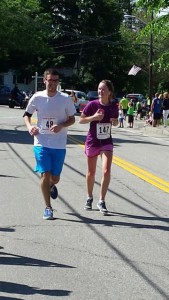By Colette House
Early morning runs. Extend the distance, monitor nutrition for optimal performance and making running the single-pointed focus of an exercise routine.
That’s just par for the course in the months prior to the 2015 Bank of America Chicago Marathon.
Now race day is almost upon us. Despite the grueling training, approximately 45,000 people plan to run in the Chicago Marathon on Sunday.
Michael Brandson, personal trainer and educator at the NCH Wellness Center in Arlington Heights, said choosing to run a marathon for the right reasons is an important component of training.
“ I think that people tend to adopt running as a fitness regimen. That’s not the reason to adopt running,” said Brandson. “The reason to adopt running is the reason to adopt any sport – because you love it and you feel you’re good at it or that you potentially will be good at it because you’re going to commit a lot of time to it.”
Brandson said people who focus solely on on the running part of training for marathon typically get injured because they neglect other areas of fitness. Those include increasing flexibility, upper body strength, and core strength. Running is only a small part of fitness, said Brandson, and having a balanced training regime can reduce the risk of injury as runners take their first strides on race day.
Brandson said that injuries also occur when people ramp up the duration or intensity of their workouts and that runners should be particularly careful when increasing the duration of their runs, a huge part of marathon training.
“That’s when people get injured, when they try to run farther or faster,” said Brandson.
Brandson said these types of increases should be done over a long period of time and that even six months of training may not be enough for non-runners to prepare for a marathon.

Ken Larscheid, 33, who owns Running Lab in Brighton, Michigan, also advises runners to avoid cramming in last-minute training sessions close to race day.
“Don’t try to fit in any extra training at this point. It’s better to rest,” said Larscheid, who is running his fourth Chicago Marathon this year.
First-time marathoners like Amelia Dougherty, a 21-year-old elementary education major at Plymouth State University in New Hampshire, aren’t sure what to expect when race day arrives, but Dougherty has spent the last several months training and preparing for possible issues that might arise on the course.
Dougherty said she followed a Nike training program that coincides with the Nike+ Running App, “religiously” for the last four months, which has her running five days a week, one day of cross-training, and one day of rest.
“I went from not running to running 18-19 miles,” said Dougherty.
Even with a structured training routine in place, Dougherty has a plan just in case injury occurs while out on the course.

“If I do get hurt I’m not going push myself,” said Dougherty. “If I feel pain I’m going to stop and give it some time.”
Brandson said experiencing pain is like seeing the top-third of an iceberg above water. The more dangerous two-thirds of the iceberg lurk below the surface, just as injury has most likely occurred and been lurking below the surface prior to the pain setting in.
“There are very serious injuries that your body communicates to you through pain, and the pain starts to appear after the injury starts to reach a pretty critical level,” said Brandson.
Bottom-line: runners need to pay attention to signals their bodies give them during training and while running the marathon. Ignoring injury in the short-term could lead to more serious injuries later on.
“Every part of your body is very important no matter how big or small it is. Our bodies function like elegant chains, and if one part of the chain doesn’t work, then the chain doesn’t work,” said Brandson.
Even when running injury-free, runners must play a mental game with themselves in order to finish a marathon.
“If you’ve done your training, you don’t have an issue from the mental standpoint,” said Larscheid. “I know when I’m ready.”
No doubt mental toughness will help runners cross the finish line, but being mentally tough doesn’t mean ignoring signs of injury.
“That’s how people get injured. They keep going and think it’s (the pain) going to go away,” said Brandson.


